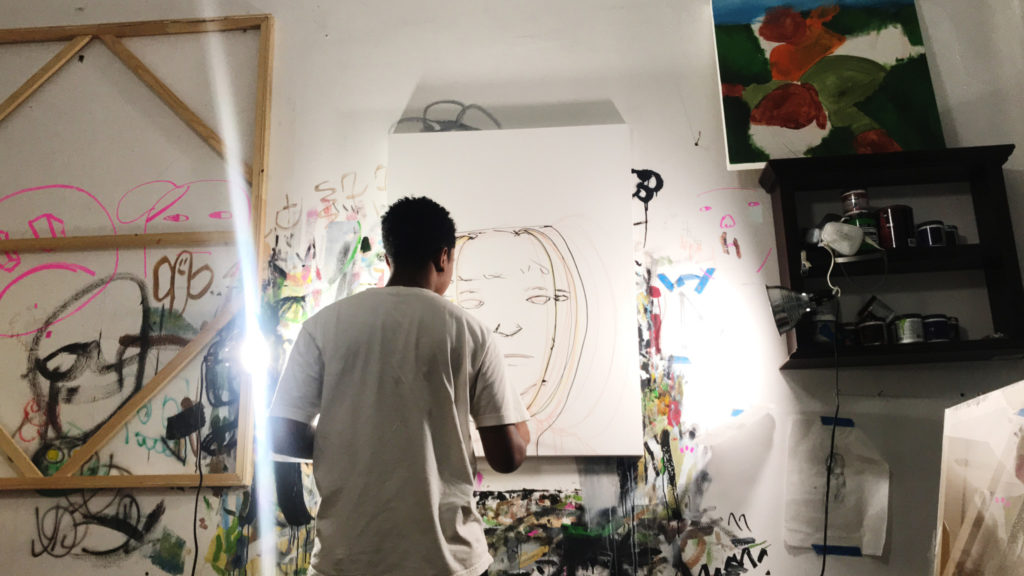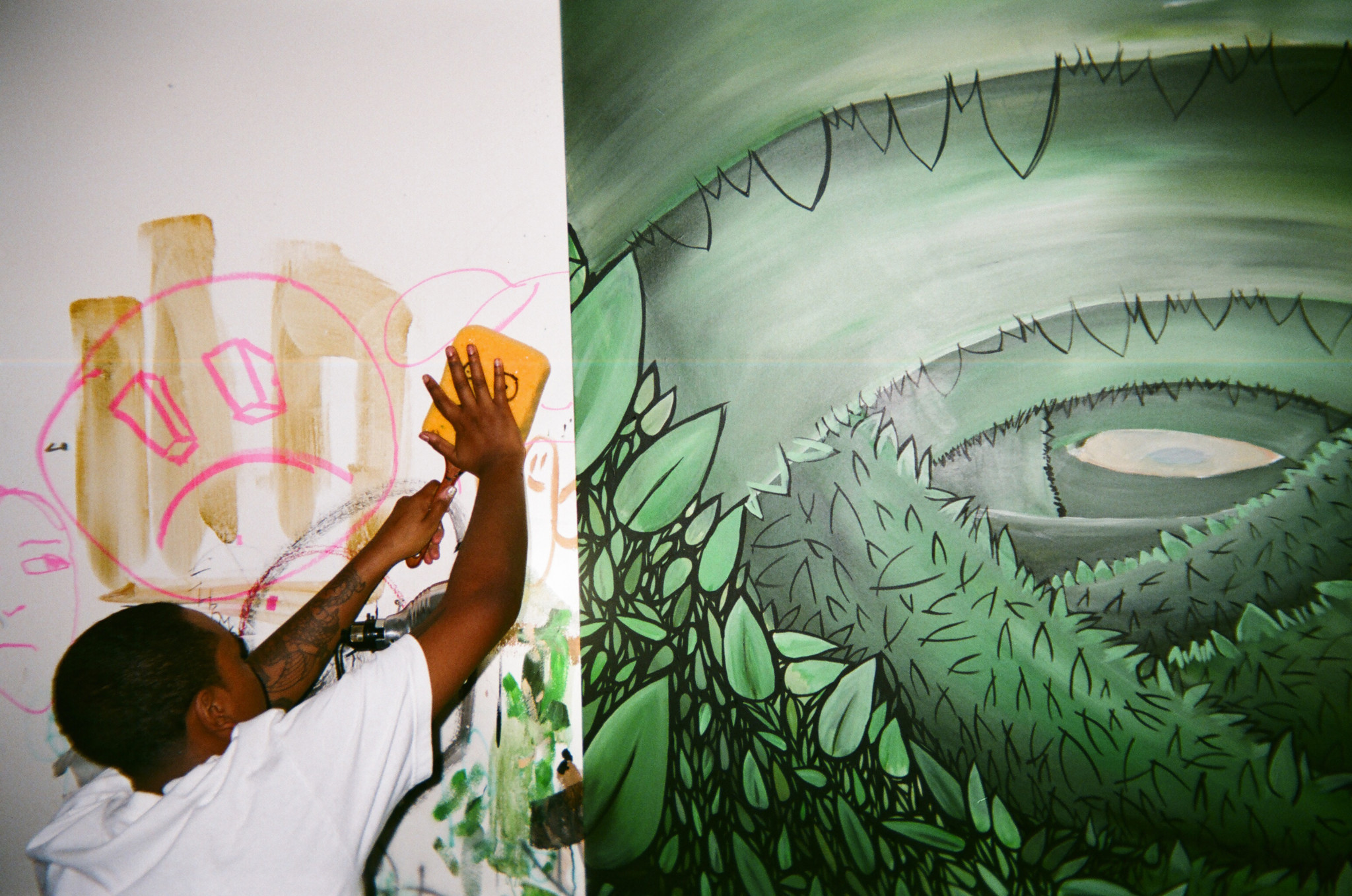Last July, Armani Howard, an artist from Roseland, had his first solo show, exhibiting “Chapter 5: This Kingdom Come” of his work, at Mo Faux Studio on the Northwest Side. The gallery was welcoming, and Appleby’s “Lady Sunshine” played from time to time.
On a thirty-six-by-forty-eight-inch canvas titled “Word is Bond,” four boys stood with arms around each other’s shoulders along with a mouse, glaring at the audience. The upper half had a black background, and the bottom half of their bodies went unseen as they disappeared into a pool of white, which it turned out to be a wormhole.
Howard explained the secret to finding the meaning of the work: “By using two different varnishes, matte and gloss, you can see one or the other in different lighting. Gloss reflects light, where matte does not. With that, you can see [how] the different tones and illusions are created.”
Howard wants people to look at things from a different perspective. The idea behind the work is the frustration of communication. In other paintings, characters stood fierce with eye patches and heads of burning fire, insomniac scenes with identical girls shooting blue and golden forces at one another, distorted faces, “shadow creatures,” and concrete guardians.
On the debut of this chapter, Howard said, “This stage mainly talks about the introduction to the world and the narrative that is being created, primarily focusing in on the first king who is a prominent character within the book and necessary point of discussion. It’s about getting viewers comfortable with the imagery that comes with it and how that imagery can grow and change.”
As night fell, family members, friends, and other artists familiar with Howard’s work popped in to see the pieces from “Chapter 5: This Kingdom Come.” They came across not only Howard’s imagination in practice, but also a part of his life. “The work first stems from me wanting to find a way to talk about my personal growth,” he said. “I always take my personal situation into account, this work is, for where its at, and where it continues to grow just a reflection for what I’ve experienced so far in my life.”
The kids in Howard’s paintings inhabit a fictional world he created that serves as a moral compass for himself and his art. In these works, the children are not just floating but actually ascending toward adulthood. Howard depicts them in that transition period because “children have a lot more power than we give them, and having them at a central standpoint for the work, I enjoy that it allows them to grow.”
All of Howard’s art comes from his book, Into The Wild, a blueprint for his fictional world. The book is written in a language Howard calls his own, a mix of letters and alphabetic language that appear in his work. “There is no name for the language,” he explained. “It is a way for the kids [in my work] to communicate with one another…It made the world tangible and realistic for me.”
Armani describes his book as something that helped him meditate on his life. “In order for me to reflect on that, I had to make something that I could see from the outside standpoint that was pretty true to myself, that I could visualize.”
The themes explored within his works are based on the morals and ideas given to him by his mother, which Howard uses to guide the children within the world. He said he “wanted the kids to engage with the idea of this compass that I’ve made for my own personal life, and for this fictional world.”

In the August after his freshman show, Howard gave a group of students in After School Matters, a non-profit organization for Chicago high school teens that he attended himself, an artist talk in the gallery space. Some asked questions while others stared into the work, pointing to details they liked. It was not until Howard gave them what he called the “real talk” that the students really became focused, as if something clicked and heard something they had been waiting for.
He split the group up between those who were interested in pursuing art, those not sure if they wanted to pursue art, and those not interested in art at all. As Howard pointed to what seemed to be the unsure group, everyone scattered and joined one of the more definitive groups, leaving one girl in a colorful dress to defend for herself. When asked why she was unsure, she said, a bit hazily “I want to learn how to animate but I also really like doodling in general and digital art and stuff but I also really like science….I’m kind of at this crossroad where I have to be like, science or art? I don’t know exactly what I’m going to do with it.”
Howard told her and her classmates that they didn’t have to choose; merging different crafts and studies was also an option. “You have options. That’s the thing about college, there’s [usually] an art department in any school you’re in…so who says that you can’t be an artist and a chemist as well?”
When reflecting on the experience of the talk he had given to the class, he remarked, “I remember being that kid…feeling sometimes like a big part of it is you’re used to adults telling you one thing and you should think a certain way or do a certain thing. I think there are key points that I wish when I was younger that someone told me that you didn’t have to just focus on one thing, you should just try to do as many things as you can…you should be open to the people around you because you never know what they can teach you.”
Speaking on his experience at After School Matters, Howard said, “I signed up for After School Matters and saw it as a way to make money,” referring to the stipends students receive in the program. He eventually realized that the program was more than just a stipend, and it became more about the effect the work was having on him, “It dumped me into this thing that made me feel something for the first time, that made me feel a certain way about myself that was more positive and so as I gained the technical ability, I could execute that idea.”
Each show is a countdown, starting from Chapter 5, of the chapters in his book. “As each show progresses, you’re getting…an introduction to the world,” he said.
Shortly after his first solo show and his talk with the students at ASM, Howard was already back to working on the pieces that would later be included in “Chapter 4” in February. In the studio space that he shares with Nikko Washington in the Fine Arts Building, Howard was in the middle of making a big skull on a forty-by-forty-inch canvas. Titled “Broken Hearts Club,” it went into February’s exhibit, which would be centered on breaking down situations and presenting them as ideas, rather than in their actuality. “Broken Hearts Club” takes from Howard’s personal experience of getting advice from older generations to find a partner and settle. The painting was not an actual scene of people together and getting tired and old, but rather the idea of it.
One thing Howard wants to teach his audience is that the process of things should never be undermined; the beginning of a project is the foundation for building an idea. According to Howard, every part of the process is equally as important to the final result as the completion of the idea itself. The characters that once begin as escapist thoughts in sketchbooks are the keys that will act as leading roles in his narratives. He believes in allowing the childlike view of the world to navigate the craft, and he went on to explain how this idea is interpreted in the style of his work when using his left hand (because he’s right handed) to make drawings as if a kid had done it, stating, “some of the line work and stuff that happens in the background that looks like drawings, [but] sometimes reality doesn’t come as clean.”
At one point, Howard’s mother Lena joined our interview. He went from wall to wall, picking up the paintings that hung on display and explaining them to his mother, a major support system for all of his work. He explained that part of the reason he wants to discuss communication in his illustrations and narratives is because she always stated it is a key point in life.
Holding “Comeback Kid” on a sixty-by-thirty-six-inch canvas, the painting moved with his energy, as it illustrated a one-eyed boy with a patch and another kid with fire for a head, both on a deep red background. “This piece is about becoming friends with your demons and realizing you shouldn’t be afraid of them,” Howard explained.
Next Howard reached for “Budding,” identical characters on a thirty-by-forty-inch canvas. The piece contains a 24-karat gold leaf stamped in the center, giving the illusion that indeed it is burning a light through the canvas. Blue and black clouds transgress above a forest that lurks behind a girl with an esoteric face beginning to decompose. A similar girl stands next to her with an exposed skeleton.
As he waved this painting to show us, circulating the living room space, it was almost like we existed in the same realm as the characters in the paintings, as if they were portals from which they entered and demanded recognition.
Howard’s “Chapter 4: Shapes us all” arrived on a cold winter night this past February, hosted in the intimate space of Vault Gallery located in East Pilsen. Wooden carve-outs of floating children and falling birds were scattered around the room, and rocks jutted from the canvasses. Everywhere, eyes were watching.
Howard’s next show solo, Chapter 3 of the latest installment from Into the Wild, exhibits this Friday, April 5th, at AdventureLand Gallery, 1513 N. Western Ave., from 6pm–10pm.
Correction, April 3, 2019: Armani Howard’s piece “Broken Hearts Club” was mistakenly referred to as “GOIGO.”
Natasha Estevez is a Multidisciplinary Storyteller who dedicates Multiple odes to everything that has pulled her out the Muck. This is her first piece for the Weekly.


Very proud of his work and your article to express the convos.. young aspiring artists????????????????????????
Natasha, I really enjoyed meeting you and Armani at the opening on Western a few weeks ago. Good work!